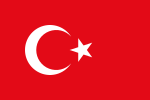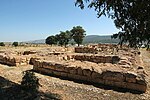Palaic is an extinct Indo-European language, attested in cuneiform tablets in Bronze Age Hattusa, the capital of the Hittites. Palaic, which was apparently...
9 KB (827 words) - 12:59, 3 October 2024
Pala (Anatolia) (redirect from Palaics)
its native Palaic language and its native religion. Their language shared common innovations with Luwian not present in the Hittite language suggesting...
5 KB (411 words) - 11:37, 12 January 2024
Pala may be : Palaic language Pela language Pa'a language a dialect of the Luma language a dialect of the Patpatar language This disambiguation page lists...
164 bytes (53 words) - 08:31, 15 June 2024
divides the latter node into Lydian, Palaic, and a Luwian group (instead of Luwic). Hittite (nešili) was the language of the Hittite Empire, dated approximately...
43 KB (4,808 words) - 16:07, 10 November 2024
Hieroglyphic Luwian, Palaic, Lycian, Milyan, Lydian, Carian, Pisidian, Sidetic and Isaurian. Unlike most other Indo-European languages, Hittite does not...
38 KB (3,515 words) - 13:15, 30 October 2024
eastern shore of the Propontis, may have displaced the speakers of the Palaic language from their home in Pala.[citation needed] The Kaska first appear in...
10 KB (1,322 words) - 05:26, 23 October 2024
in northern Anatolia, where the extinct Palaic language (or Palaumnili), a part of the Indo-European language family, was spoken. Pala, California, a...
2 KB (351 words) - 13:07, 10 March 2023
Ancient text corpora (category CS1 German-language sources (de))
3000 words the Palaic language few hundred words. Hieroglyphic Luwian the Lycian alphabet (the best attested Anatolian successor language written in alphabetic...
47 KB (5,403 words) - 08:13, 24 August 2024
alongside Hittite and Palaic. As Luwian has numerous archaisms, it is regarded as important to the study of Indo-European languages (IE) in general, the...
50 KB (5,765 words) - 16:57, 9 November 2024
The Ancient Languages of Asia Minor. Cambridge University Press. pp. 6–30. ISBN 978-0-521-68496-5. Melchert, H. Craig (2008). "Palaic". In Woodard,...
115 KB (6,845 words) - 04:57, 9 November 2024
The Kalašma language, or Kalasmaic, is an extinct Anatolian language spoken in the late Bronze Age polity of Kalašma, which lay on the northwest fringe...
4 KB (343 words) - 05:37, 2 September 2024
Indo-European languages. Far more work has gone into reconstructing PIE than any other proto-language, and it is the best understood of all proto-languages of its...
63 KB (5,751 words) - 17:24, 1 November 2024
large area and their language was spoken after the collapse of the Hittite Empire. The least known Anatolian group were the Palaic peoples, who inhabited...
11 KB (1,095 words) - 06:39, 3 November 2024
Wasusarmas (category Articles containing Palaic-language text)
Luwian term wāšu, meaning lit. 'good', and which was itself a cognate of Palaic wāsu- (𒉿𒀀𒋗), meaning lit. 'well', and of Sanskrit vásu- (वसु) and Avestan...
22 KB (2,249 words) - 12:00, 11 November 2024
Anatolian? Lydian / Maeonian (𐤮𐤱𐤠𐤭𐤣𐤸𐤯𐤦𐤳 – Śfardẽtis) Palaic (Northern) Palaic Unclassified Kalasmian / Kalašma / Kalasmaic Proto-Agni-Kuči ("Proto-Tocharian")...
128 KB (7,062 words) - 07:51, 5 November 2024
extinct language may be narrowly defined as a language with no native speakers and no descendant languages. Under this definition, a language becomes...
195 KB (7,140 words) - 03:51, 4 November 2024
The Sidetic language is a member of the extinct Anatolian branch of the Indo-European language family known from legends of coins dating to the period...
14 KB (1,135 words) - 16:48, 20 September 2024
Turkey (category Articles containing Turkish-language text)
Hurrian language was used in northern Syria. Hittite, Luwian, and Palaic languages were in the Anatolian sub-group of Indo-European languages, with Hittite...
278 KB (24,907 words) - 16:33, 2 November 2024
*Dyēus (category CS1 Ewe-language sources (ee))
goddess of the day and counterpart to Greek Hemera, Hittite siwat ("day"), Palaic Tīyat- ("Sun, day"), Ancient Greek endios ("midday"), Old Armenian tiw (տիւ...
61 KB (6,064 words) - 01:57, 2 November 2024
Hittites, Anatolian peoples included Luwians, Palaic peoples and Lydians. They spoke Anatolian languages. Other incoming people include Armenians, Greeks...
10 KB (897 words) - 06:51, 3 November 2024
according to Melchert that merger was a secondary shared innovation in Hittite, Palaic and Luwian, but not in Lycian. Concordantly, Common Anatolian had the following...
10 KB (1,270 words) - 07:46, 21 September 2024
Greek Zeus, Latin Jupiter, and Norse Tyr. While Tiwaz (and the related Palaic god Tiyaz) retained a prominent role in the pantheon, the Hittite cognate...
6 KB (772 words) - 21:11, 6 October 2024
Pelasgians (redirect from Pelasgian language)
derive from the adjectival suffix also seen in cuneiform Luwian and some Palaic; the classic example is Bronze Age Tarhuntassa (loosely meaning "City of...
74 KB (8,671 words) - 09:04, 29 October 2024
The Pisidian language is a member of the extinct Anatolian branch of the Indo-European language family spoken in Pisidia, a region of ancient Asia Minor...
8 KB (770 words) - 19:20, 21 May 2024
Ziparwa (category Palaic mythology)
the "extremely heterogenous" pantheon of the Palaians, speakers of Palaic, a language closely related to Hittite and Luwian. In the Bronze Age they inhabited...
8 KB (989 words) - 23:26, 19 January 2024
Hattic speaking; that the Hattic language is found in the Sapinuwa archive alongside an apparent paucity of the Palaic language; and that the name of the city...
14 KB (1,672 words) - 00:53, 11 November 2024
Indo-European vocabulary (category CS1 Polish-language sources (pl))
Shevoroshkin, the noun exists in other Anatolian languages: Lycian ziw-; Lydian civ-; Luwian Tiwa-; Palaic Tija-. Other dialectal variants are Cretan awélios...
341 KB (8,992 words) - 18:21, 5 November 2024
Cuneiform (redirect from Transliterating cuneiform languages)
other Anatolian languages, namely Luwian (alongside the native Anatolian hieroglyphics) and Palaic, as well as for the isolate Hattic language. When the cuneiform...
348 KB (10,291 words) - 22:48, 30 October 2024
Anatolia (category Articles containing Turkish-language text)
tribal Kaskians, a non-Indo-European people who had earlier displaced the Palaic-speaking Indo-Europeans. Much of the history of the Hittite Empire concerned...
79 KB (8,020 words) - 04:07, 8 November 2024














